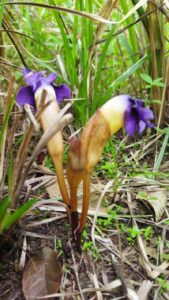How to Propagate Aeginetia acaulis

Unseen Wonders: Demystifying the Propagation of the Ghostly Forest Flower
Imagine a flower, devoid of any green leaves, emerging straight from the forest floor, its delicate bloom a surprising splash of color against the brown. This ethereal beauty is the Aeginetia acaulis, aptly nicknamed the “Forest Ghost Flower” or “Fairy’s Pipe.” This fascinating plant, while stunning, is shrouded in mystery for most. Today, we’ll shed some light on one of its most intriguing aspects – its unusual propagation.
A Parasite with a Purpose
Before diving into propagation, it’s crucial to understand what makes the Aeginetia acaulis so unique. This fascinating species belongs to a rare group of plants called holoparasites. Unlike typical plants that obtain energy from sunlight through photosynthesis, the Aeginetia acaulis lacks chlorophyll and depends entirely on a host plant for its survival. It draws nutrients and water from the roots of specific plants, often members of the ginger family.
This parasitic lifestyle plays a crucial role in the plant’s reproduction, making its propagation a fascinating story of dependence and adaptation.
The Secrets of the Seed
Aeginetia acaulis propagates primarily through seeds, minuscule and numerous, like most flowering plants. However, that’s where the similarity ends. These seeds possess unique characteristics and face extraordinary challenges:
- Dust-like and Abundant: The seeds are incredibly small, almost dust-like, allowing for easy dispersal by wind or water. This adaptation increases the chances of landing near a suitable host.
- Host Dependency for Germination: The seeds themselves cannot trigger germination without a signal. Instead, they remain dormant in the soil, patiently waiting for their specific host plant to release certain chemicals into the surrounding environment.
- Chemical Cue: When a suitable host is nearby, these chemical signals act as a trigger, prompting the Aeginetia acaulis seeds to germinate and grow towards the host’s roots.
A Partnership Rooted in Nature
Once the seedling attaches to the host’s roots, it develops a specialized structure called a haustorium. This structure penetrates the host’s root system, forming a direct link for nutrient transfer. From this point on, the Aeginetia acaulis relies entirely on its host for sustenance, enabling it to grow and eventually bloom.
Cultivation: A Rare and Challenging Feat
Due to its complex relationship with its host plant, cultivating Aeginetia acaulis outside its natural habitat is extremely challenging and rarely attempted. The specific host requirements, coupled with the precise environmental conditions the plant needs, make successful propagation a difficult task even for seasoned botanists.
Conservation and the Future
The Aeginetia acaulis, like many specialized species, faces threats from habitat loss and climate change. Understanding its unique propagation methods is crucial for researchers looking to conserve this fascinating plant. Further research could shed light on potential propagation techniques that could aid in preserving this intriguing species for future generations.
A Glimpse into Nature’s Complexity
The story of Aeginetia acaulis propagation provides a glimpse into the fascinating and often unseen world of plant interactions. It showcases the intricate web of life that exists in nature and reminds us of the delicate balance within ecosystems. Although challenging, understanding the complexities of this plant’s life cycle can guide conservation efforts and ensure the survival of this ghostly beauty for years to come.